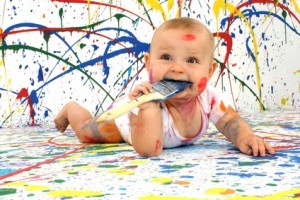Updated, March 2019
Esta página en Spanish | This page in Spanish
Childhood is a time of tremendous growth and learning. How very exciting to be a baby…or a two-year-old… or get on a school bus for the first time. There’s so much to know!
We all come into the world like small waiting sponges, ready to absorb what’s around us. Yet we’re all different, too—another of life’s little marvels. We also develop at different rates. Some children speed along, practically running before they walk. Others take their time–or need more time. And still others may ultimately need four wheels to get around.
Parents, siblings, grandparents, daycare providers, teachers, and friends watch eagerly for each new step and progression in a child’s skills. If a skill is not learned “on time,” they may worry. Juana’s not sitting up yet, but the baby next door is. Hannah should be talking in full sentences by now! Frank and Ahmed aren’t learning to read as easily as the rest of the class.
But what’s “on time?” What’s “normal?” Does “normal” have a range?
Yes, “normal” has a range. But growth does tend to follow a certain sequence. Skills are expected to emerge at more or less the ages described below. Here are just a few of many milestones a typically developing child reaches in the first year of life and beyond.
By 3 months of age
Motor Skills
- lift head when held at your shoulder
- lift head and chest when lying on his stomach
- turn head from side to side when lying on his stomach
- follow a moving object or person with his eyes
- grasp rattle when given to her
- wiggle and kick with arms and legs
Sensory and Thinking Skills
- turn head toward bright colors and lights
- turn toward the sound of a human voice
- recognize bottle or breast
- respond to your shaking a rattle or bell
Language and Social Skills
- make cooing, gurgling sounds
- smile when smiled at
- communicate hunger, fear, discomfort (through crying or facial expression)
- usually quiet down at the sound of a soothing voice or when held
By 6 months of age
Motor Skills
- hold head steady when sitting with your help
- reach for and grasp objects
- play with his toes
- help hold the bottle during feeding
- explore by mouthing and banging objects
- move toys from one hand to another
- pull up to a sitting position on her own if you grasp her hands
- sit with only a little support
- roll over
- bounce when held in a standing position
Sensory and Thinking Skills
- open his mouth for the spoon
- imitate familiar actions you perform
Language and Social Skills
- babble, making almost sing-song sounds
- know familiar faces
- laugh and squeal with delight
- scream if annoyed
- smile at herself in a mirror
By 12 months of age
Motor Skills
- drink from a cup with help
- feed herself finger food like raisins
- grasp small objects by using her thumb and index or forefinger
- use his first finger to poke or point
- put small blocks in and take them out of a container
- knock two blocks together
- sit well without support
- crawl on hands and knees
- pull himself to stand or take steps holding onto furniture
- stand alone momentarily
- walk with one hand held
Sensory and Thinking Skills
- copy sounds and actions you make
- respond to music with body motion
- try to accomplish simple goals (seeing and then crawling to a toy)
- look for an object she watched fall out of sight (such as a spoon that falls under the table)
Language and Social Skills
- babble, but it sometimes “sounds like” talking
- say his first word
- recognize family members’ names
- try to “talk” with you
- respond to another’s distress by showing distress or crying
- show affection to familiar adults
- show apprehension about strangers
- raise her arms when she wants to be picked up
- understand simple commands
For children older than 12 months
If you’d like to know more about what experts consider the developmental milestones for children older than 1 year, we refer you to the resource links identified below.
American Association of Pediatrics
has a wealth of parent information and practice guidelines related to well-visit checkups, developmental screening, as well as articles on health conditions, and childhood diseases and treatments, all available on their web site or through their bookstore.
https://www.healthychildren.org/English/ages-stages/Pages/default.aspx
The Centers for Disease Control and Prevention (CDC) | Act Early
has a vast network of collaborative organizations, one of which is The National Center on Birth Defects and Developmental Disabilities (NCBDDD). From its web site you can find information related to preventing birth defects, developmental disabilities, and links to fact sheets on developmental screening, developmental milestones, and an interactive developmental checklist (called the Milestone Tracker) in English and Spanish.
https://www.cdc.gov/ncbddd/actearly/index.html
March of Dimes
Developmental Milestones for Babies (0-2 yrs.)
https://www.marchofdimes.org/baby/developmental-milestones-for-baby.aspx
American Speech Language Hearing Association
Typical speech and language development.
https://www.asha.org/public/speech/development/default.htm
National Institute on Deafness and Other Communication Disorders
Speech and language developmental milestones.
https://www.nidcd.nih.gov/health/speech-and-language
Pathways Awareness Foundation
Development in toddlers (1-3 years old).
https://pathways.org/growth-development/toddler/
Center on the Developing Child at Harvard University.
Fascinating research on how the brain develops, including this video, The Science of Early Childhood Development, in English and in Spanish.
https://developingchild.harvard.edu/


